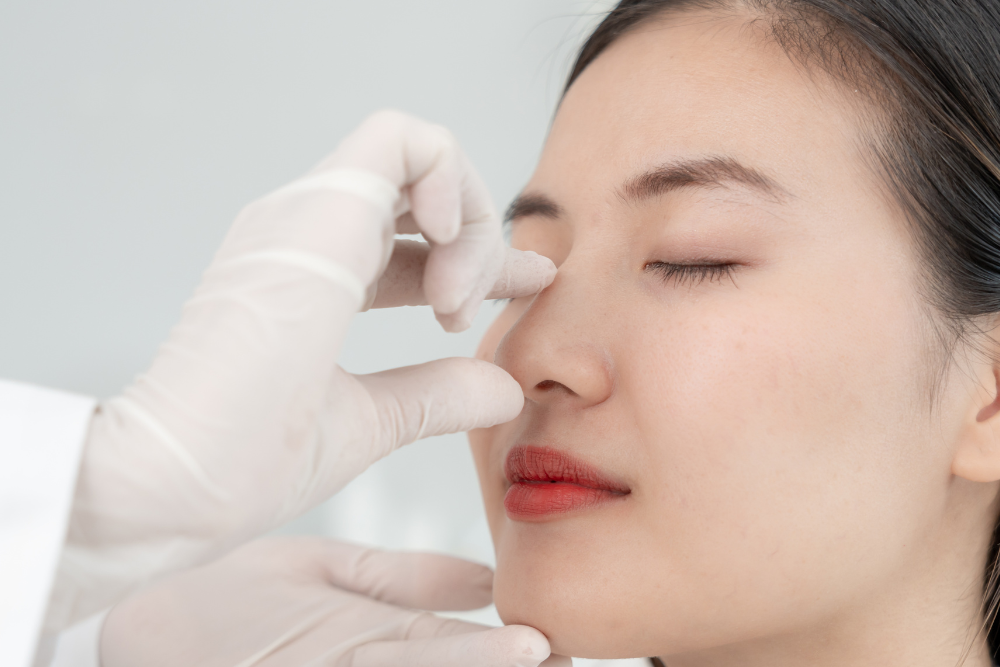





Delivering Excellence in Facial Plastic Surgery
Precision. Passion. Perfection
Safe, Artful Transformations for Your Face
Comprehensive ENT Care for Kids and Adults.
Your Family's ENT Care, Fully Addressed
Rhinoplasty: Enhancing Nasal Aesthetics
and Function.
CHIN REDUCTION SURGERY IN SINGAPORE
(REDUCTION GENIOPLASTY IN SINGAPORE)
Chin reduction surgery, also known as reduction genioplasty in Singapore or mentoplasty, is a surgical procedure designed to reduce the size of the chin to achieve a more balanced facial appearance. This procedure can be performed for both aesthetic and functional reasons.
GENIOPLASTY PROCEDURE IN SINGAPORE
Genioplasty is a surgical procedure that modifies the chin’s position and size. When it’s used to reduce the chin’s size, it’s often referred to as a reduction genioplasty. Here’s a more detailed breakdown of the chin reduction genioplasty procedure:

CONSULTATION
Before the procedure you will have an in-depth scheduled consultation with Dr. Sandeep. This will include discussing your aesthetic goals, taking medical history, and performing a physical examination. Imaging studies, like X-rays or CT scans, might be taken to evaluate the chin’s bone structure.
ANAESTHESIA
The procedure is typically performed under general anaesthesia, so the patient is asleep and feels no pain.
INCISION
Dr. Sandeep will make an incision inside the mouth (intraoral approach). The intraoral approach has the advantage of leaving no visible scars, but there’s a slightly increased risk of infection.
BONE WORK
Dr. Sandeep will use specialized instruments to cut and remove a portion of the chin bone (mandible) or reposition the bone in a more posterior and superior position. The amount of bone removed and moved depends on the desired reduction. After bony work, the chin’s tip will be repositioned and fixed in place using titanium plates and screws.
CLOSURE
The incisions are sutured closed using sutures which will dissolve on their own over time.
CHIN REDUCTION SURGERY RECOVERY IN SINGAPORE
- The patient might have a dressing or bandage applied to the chin area. Swelling, bruising, and discomfort are common post-operatively. These symptoms usually improve over a week or two.
- Pain can be managed with prescribed medications.
- If the intraoral approach was used, oral hygiene is crucial to prevent infections. Rinsing with an antiseptic mouthwash might be recommended.
- A soft or liquid diet might be advised for a few days to a week.
- Most patients can return to work and regular activities within a week or two. However, strenuous activities and exercises should be avoided for about 4-6 weeks.
FOLLOW-UP
Dr. Sandeep will schedule follow-up appointments to monitor the healing process, remove non-absorbable sutures (if used), and address any concerns.
ADVANTAGES OF REDUCTION GENIOPLASTY IN SINGAPORE
- Improved Facial Proportions: One of the primary reasons people opt for reduction genioplasty is to achieve a more balanced and harmonious facial appearance. A chin that is too prominent can overshadow other facial features.
- Enhanced Profile: The procedure can improve the side profile of an individual, making the chin align better with the rest of the facial features.
- Boosted Self-confidence: For many, having a chin that they feel is too large can be a source of self-consciousness. By adjusting the chin to a size that feels more natural and proportionate, many patients experience a boost in self-esteem and confidence.
- Functional Benefits: In some cases, a large chin can cause functional issues, such as discomfort when lying face down or difficulty fitting into certain protective equipment like helmets. Reduction genioplasty can alleviate these issues.
- Permanent Results: Unlike some cosmetic procedures that might require regular maintenance or touch-ups, the results of a reduction genioplasty are permanent.
- Minimal Scarring: The incisions made during a reduction genioplasty are typically placed inside the mouth or under the chin, making any potential scars less noticeable.
- Correction of Deformities or Asymmetry: For individuals who have chin deformities or asymmetry due to congenital conditions, trauma, or other reasons, reduction genioplasty can provide a corrective solution.
- Complementary to Other Procedures: Reduction genioplasty can be combined with other facial surgeries, such as rhinoplasty, to achieve a comprehensive facial rejuvenation or balance.
- Safety: When performed by a qualified and experienced surgeon, reduction genioplasty is generally safe with a low risk of complications.
- Improved Jaw Function: In some cases, reduction genioplasty can help in improving the function of the jaw, especially if the size of the chin was causing any misalignment or functional issues.
LIMITATIONS OF REDUCTION GENIOPLASTY
Dr. Sandeep and his team take all these factors into account when evaluating a patient’s suitability for reduction genioplasty. They strive to provide a comprehensive preoperative consultation to discuss all potential limitations and risks, ensuring that the patient can make an informed decision about their care.
LIMITED CHANGE
Reduction genioplasty can reduce the size and projection of the chin, but there are anatomical limits to how much change can be achieved without compromising function or aesthetics. Sometimes the overlying skin does not conform to the bony contouring due to its plasticity, thus rendering the procedure less effective.
AGE RESTRICTIONS
The procedure is generally not recommended for individuals whose facial bones are still growing, typically those under 18.
HEALTH CONDITIONS
Patients with certain medical conditions, such as diabetes or immune system disorders, may have a higher risk of complications and may not be suitable candidates.
NOT A COMPREHENSIVE SOLUTION
While reduction genioplasty addresses the chin, it doesn’t solve issues with other facial features. Sometimes, additional procedures like rhinoplasty or neck liposuction are needed for balanced facial aesthetics.
UNREALISTIC EXPECTATIONS
Sometimes, patients have expectations that are too high or misaligned with what the surgery can realistically achieve, leading to perceived failure of the procedure.
VARIABLE HEALING
Every patient heals differently, and individual variations in scarring or bone remodelling can affect the final result.
PSYCHOLOGICAL LIMITATIONS
Emotional well-being is essential for a successful outcome. Patients with unrealistic expectations or underlying psychological conditions may not be satisfied with the surgery.
COST
The procedure can be expensive, and it’s often not covered by insurance as it’s considered cosmetic rather than medically necessary.
DOWNTIME
Postoperative recovery requires a period of rest and limited activity, which may not be feasible for everyone due to work or personal commitments.
POSSIBILITY OF REVISION SURGERY
In some cases, a second surgery may be needed to correct issues or achieve desired results, adding to the cost and recovery time.
Dr. Sandeep and his team at The Rhinoplasty and Facelift Centre take all these factors into account when evaluating a patient’s suitability for reduction genioplasty. They strive to provide a comprehensive preoperative consultation to discuss all potential limitations and risks, ensuring that the patient can make an informed decision about their care.
POTENTIAL RISKS AND COMPLICATIONS OF CHIN REDUCTION SURGERY
Like all surgical procedures, sliding genioplasty comes with potential risks and complications. Here are some of the most common and significant ones:
- Infection: As with any surgical procedure, there’s a risk of infection at the surgical site. Proper post-operative care and antibiotics can help minimize this risk.
- Nerve Damage: The inferior alveolar and mental nerves, which provides sensation to the lower lip and chin, runs close to the area where the osteotomy (bone cut) is made. There’s a risk of damaging this nerve, which can lead to numbness or tingling in the lower lip or chin. While this is often temporary, there’s a small chance it could be permanent.
- Bone Non-union or Malunion: There’s a possibility that the repositioned bone segment might not heal properly. Non-union refers to the bone not healing or fusing at all, while malunion refers to the bone healing in an incorrect position.
- Relapse: Over time, there’s a chance that the chin could shift back towards its original position, especially if the surgically created movement was significant.
- Aesthetic Dissatisfaction: The final result might not meet the patient’s expectations in terms of appearance.
- Asymmetry: There’s a possibility that the chin might not be symmetrical post-operatively, either due to surgical technique or the healing process.
- Scarring: Even though the incision is made inside the mouth and thus not visible, there’s still a risk of scarring which could affect the tissues inside the mouth.
- Hardware Complications: The titanium plates and screws used to secure the bone segment can sometimes cause issues. They might become loose, get infected, or even be felt under the skin. In some cases, a second procedure might be needed to remove or adjust them.
- Hematoma or Seroma Formation: Blood or fluid might accumulate at the surgical site, leading to swelling and discomfort. Sometimes this may lead to infection.
- General Surgical Risks: These include risks associated with anaesthesia, blood clots, and reactions to medications.
To minimize these risks: It’s crucial to engage in a comprehensive conversation with Dr Sandeep about the possible advantages and drawbacks of the reduction genioplasty procedure to make a well-informed choice. As a patient, you can further mitigate these risks by strictly adhering to pre-surgery and post-surgery guidelines. It’s also vital to attend all subsequent check-ups to monitor healing and promptly discuss any issues.
Explore Our Other Treatments – Rhinoplasty Singapore, Facelift Singapore, Double Eyelid Surgery Singapore, Otoplasty Singapore, Upper Blepharoplasty Singapore, Brow Lift Singapore, Facial Laceration Repair Singapore, Facial Injury Repair Singapore, Lip Augmentation Singapore, Neck Lift Singapore & More!


